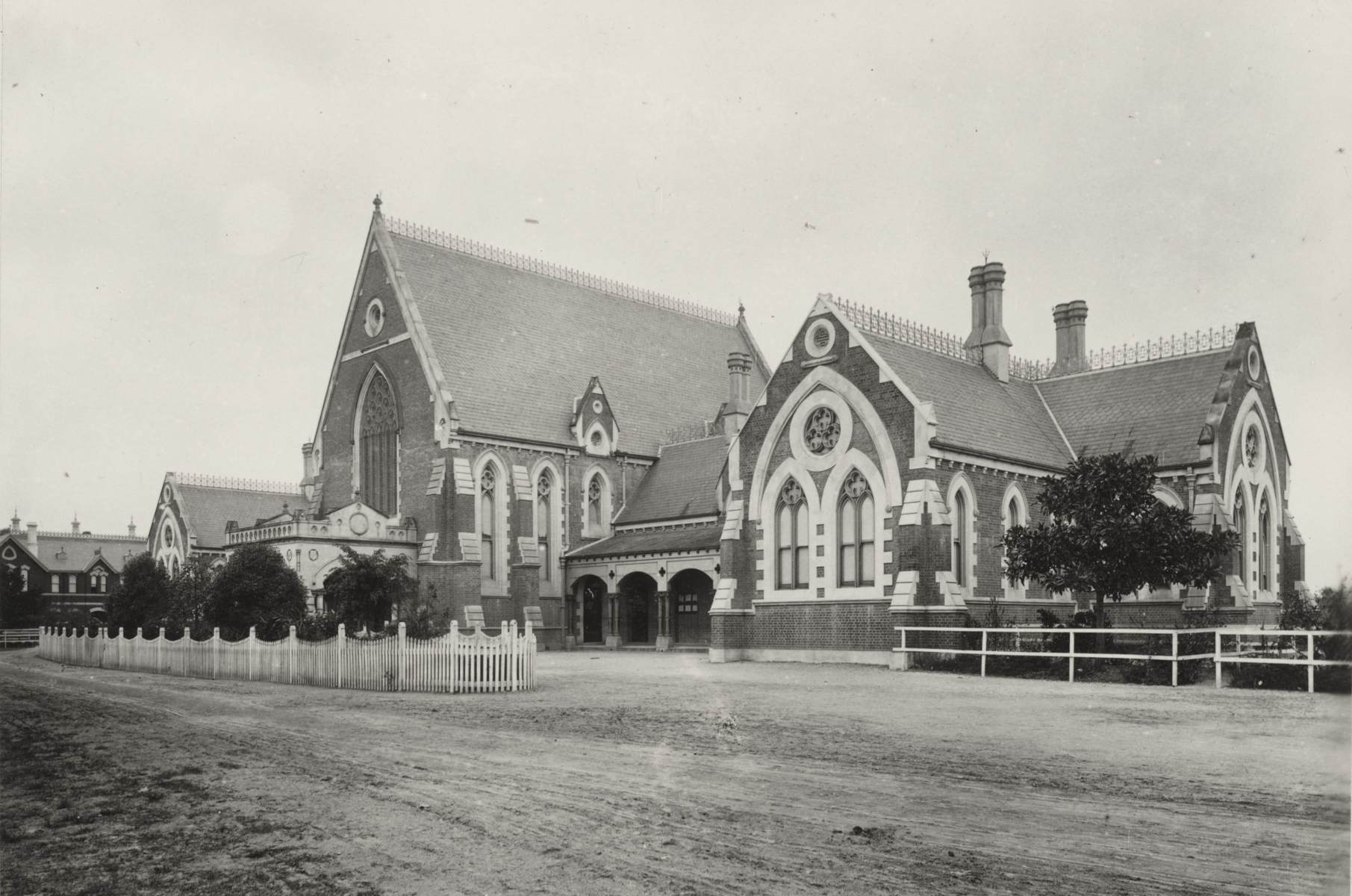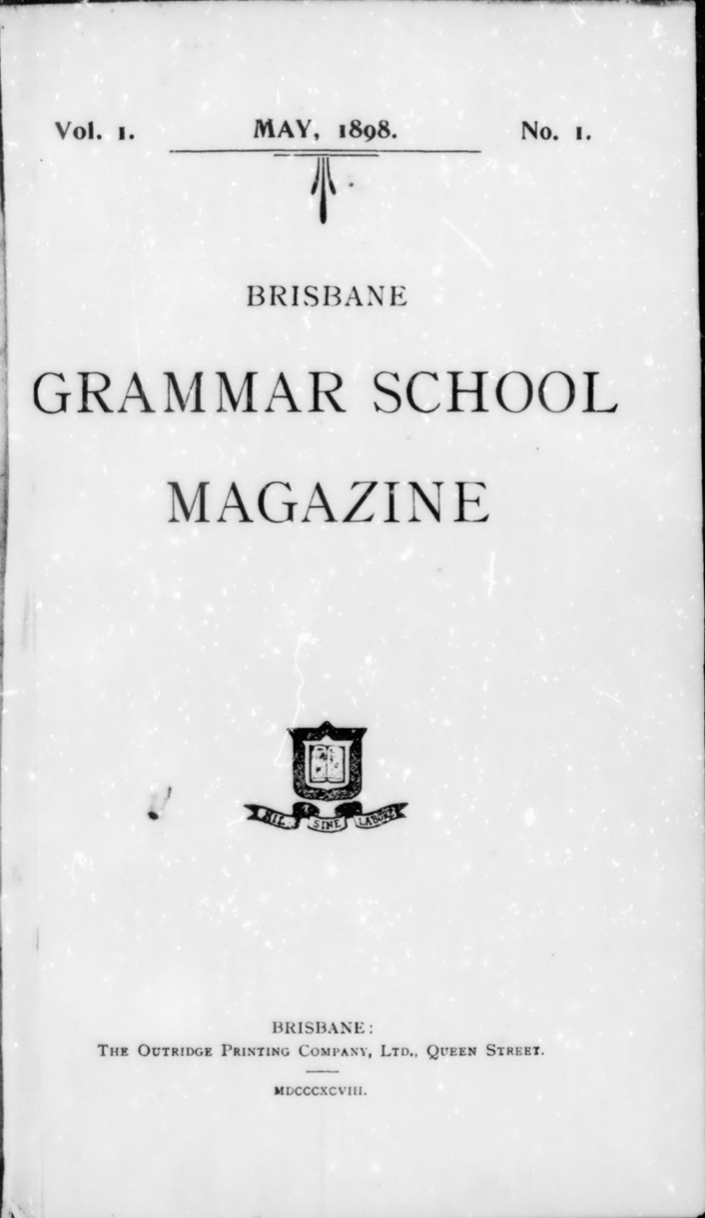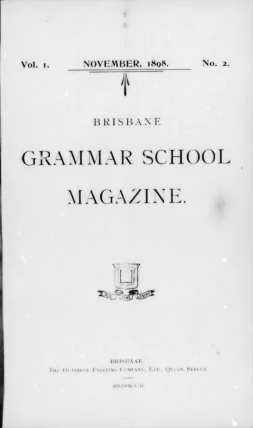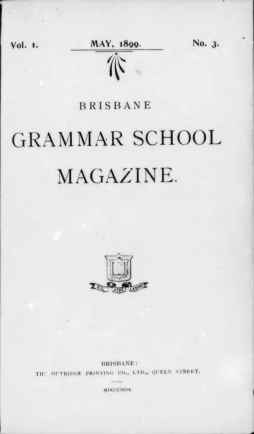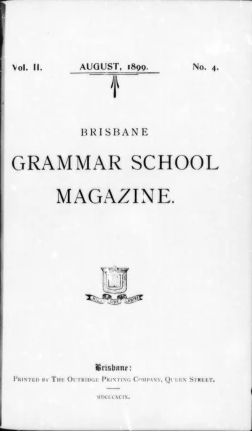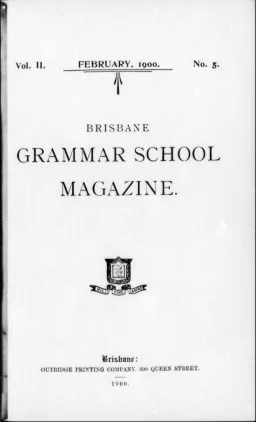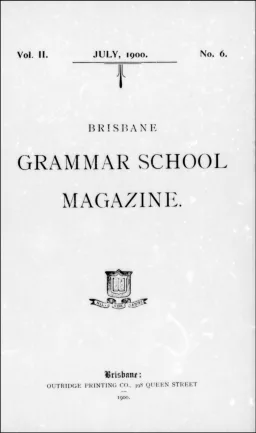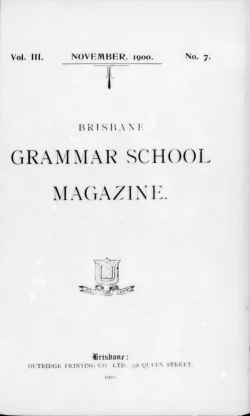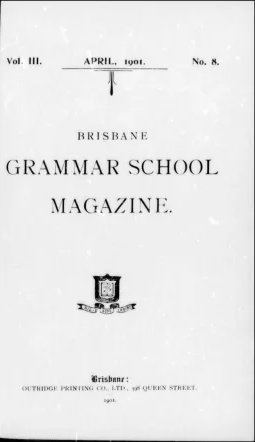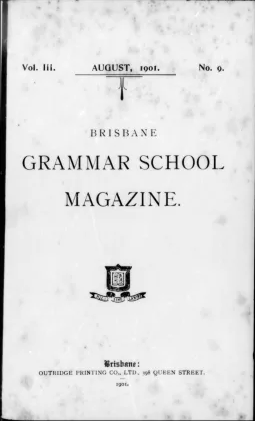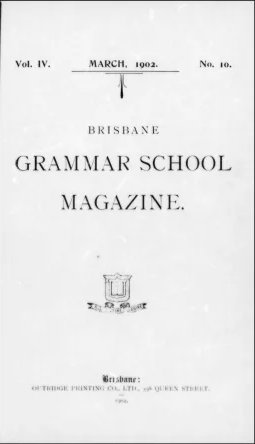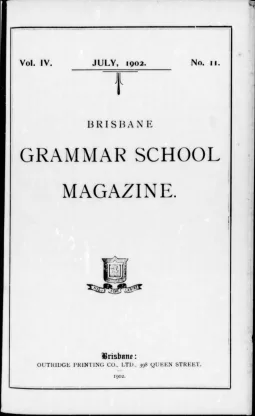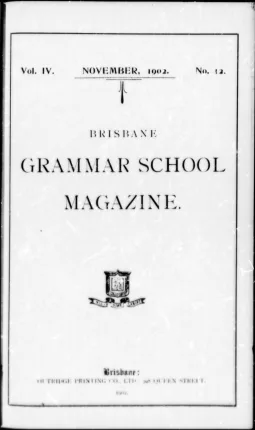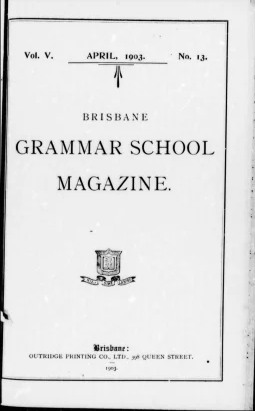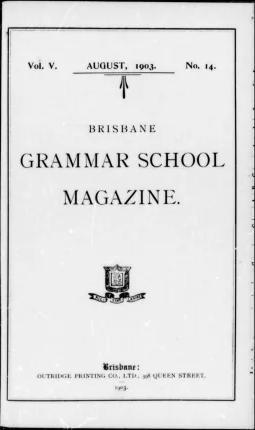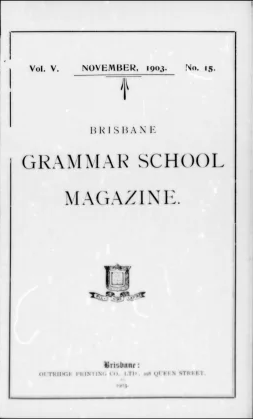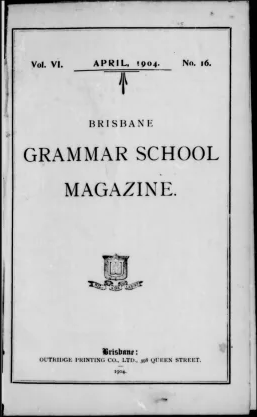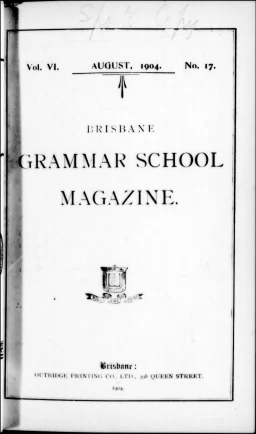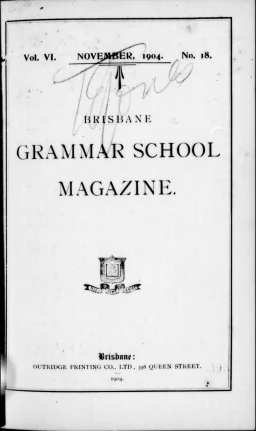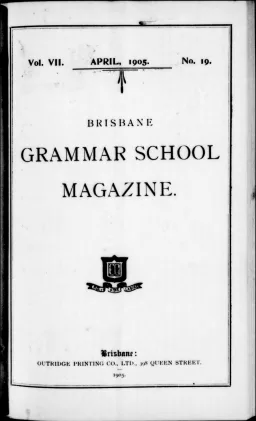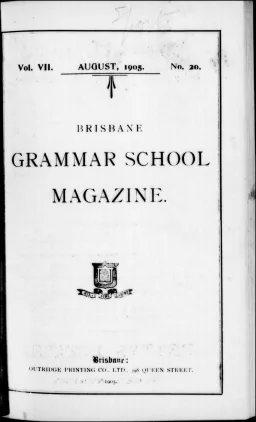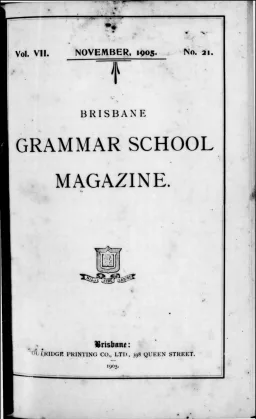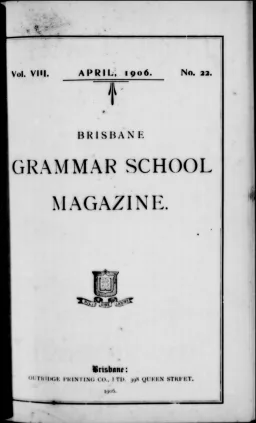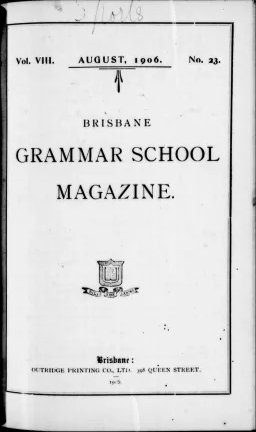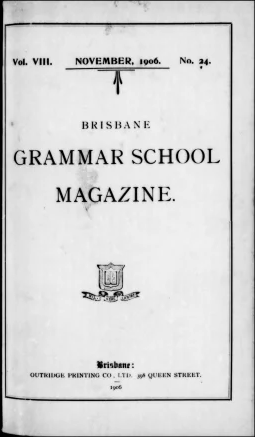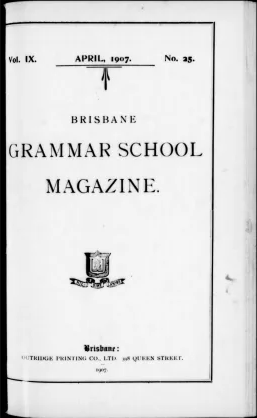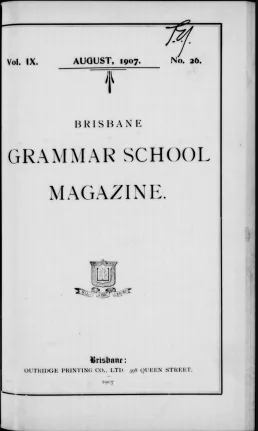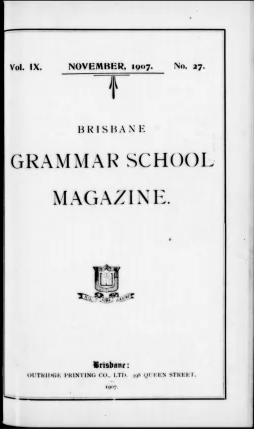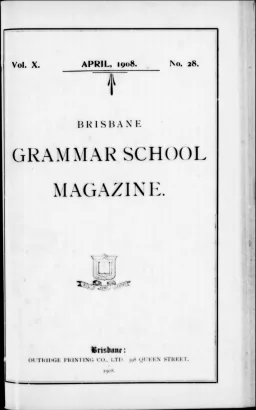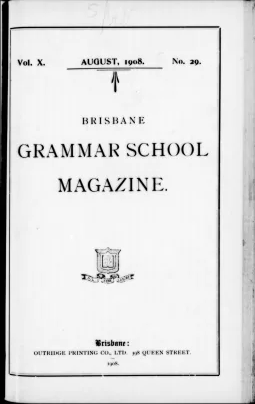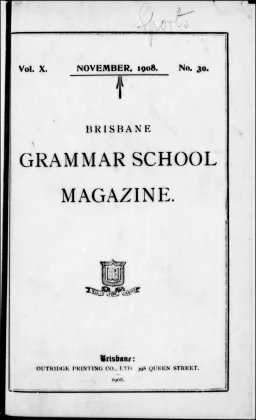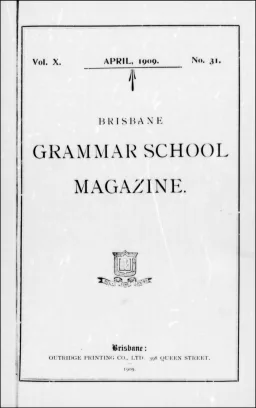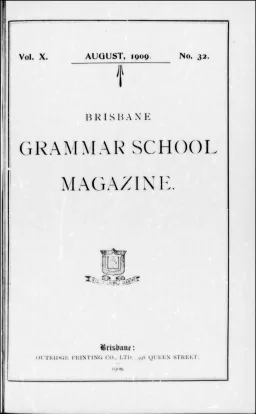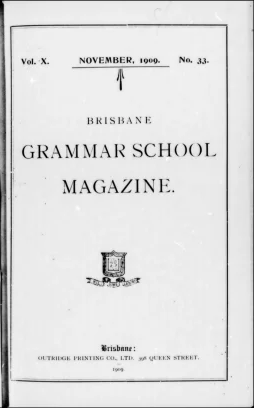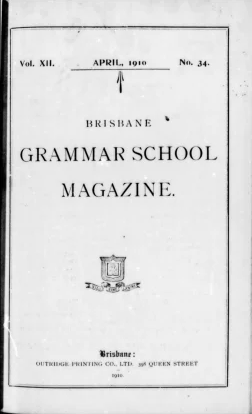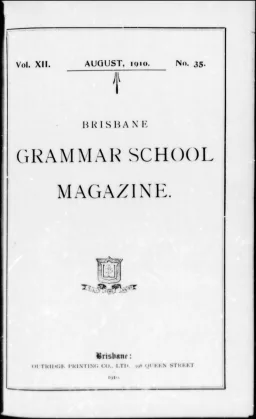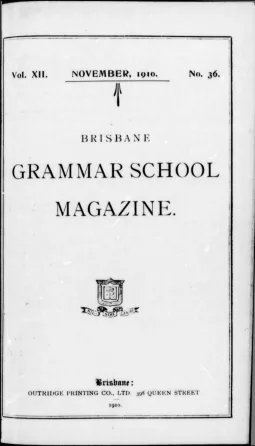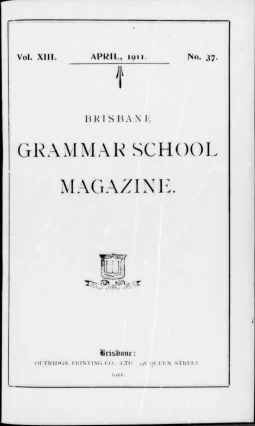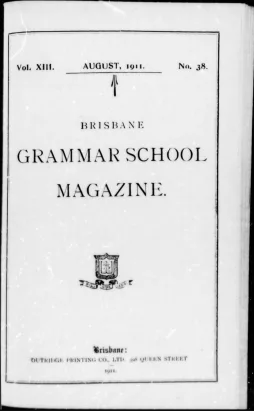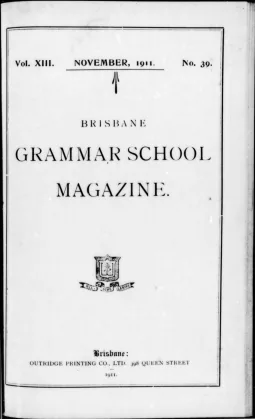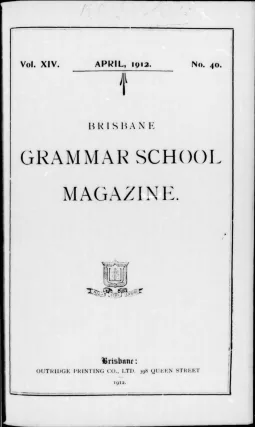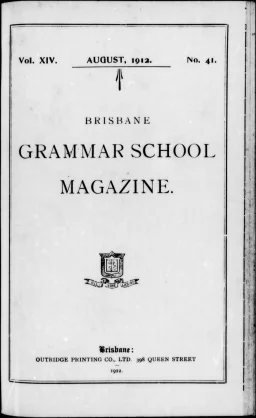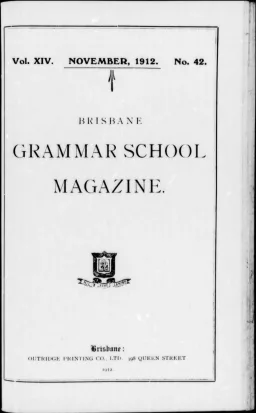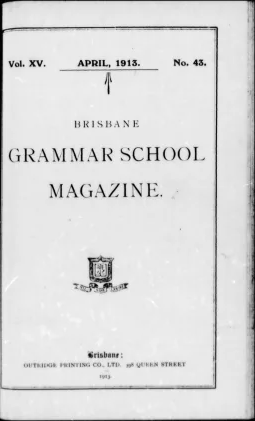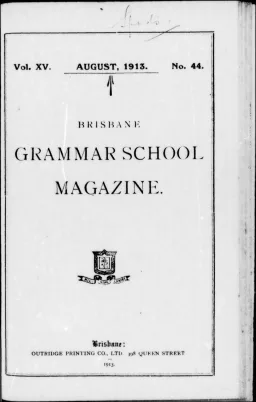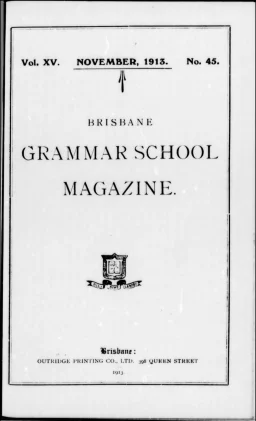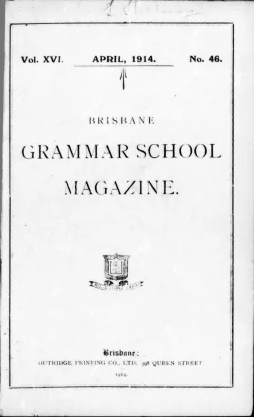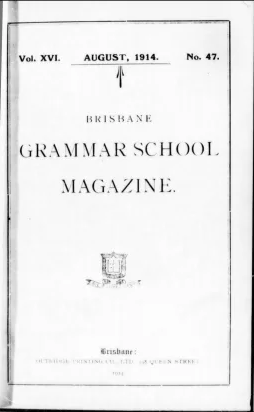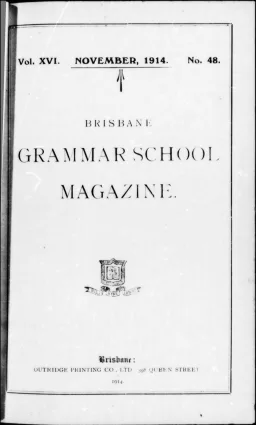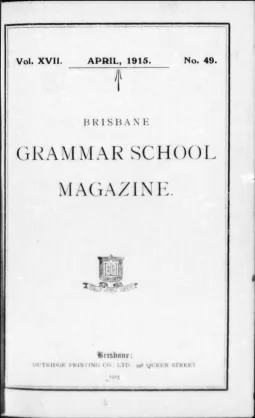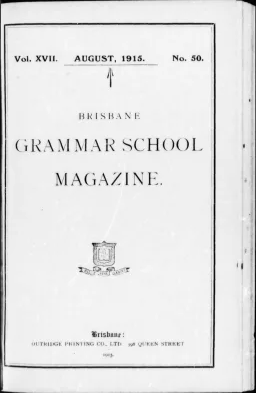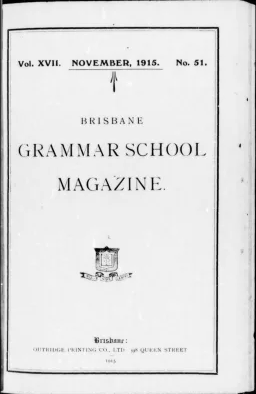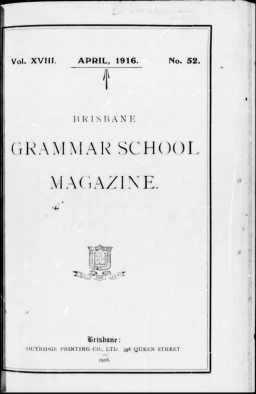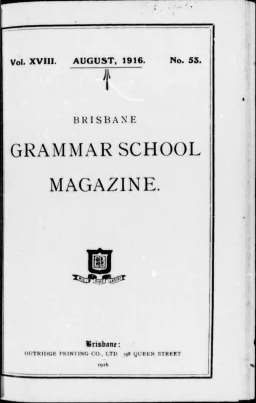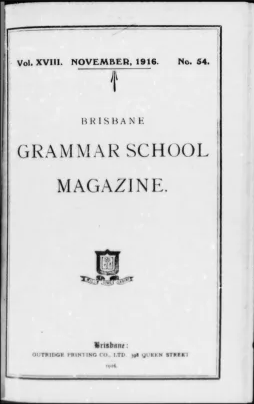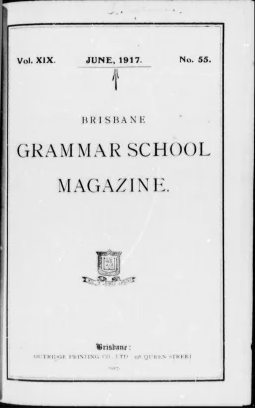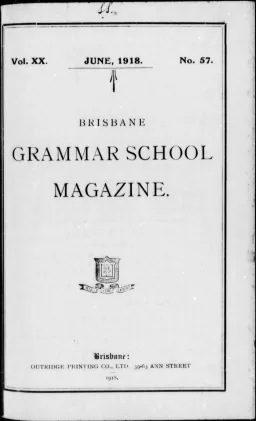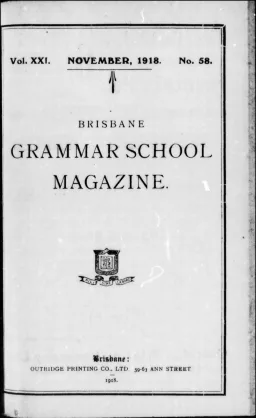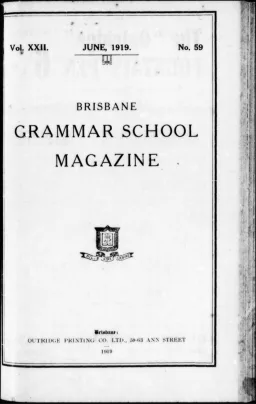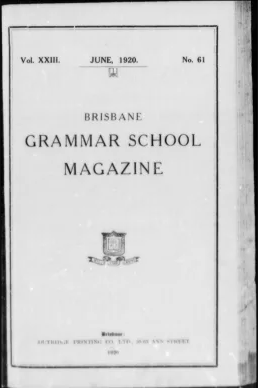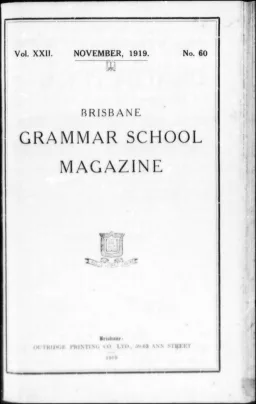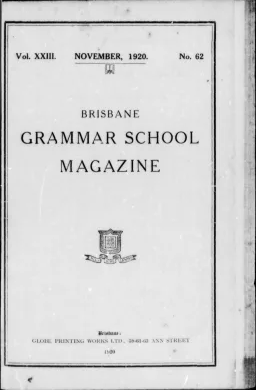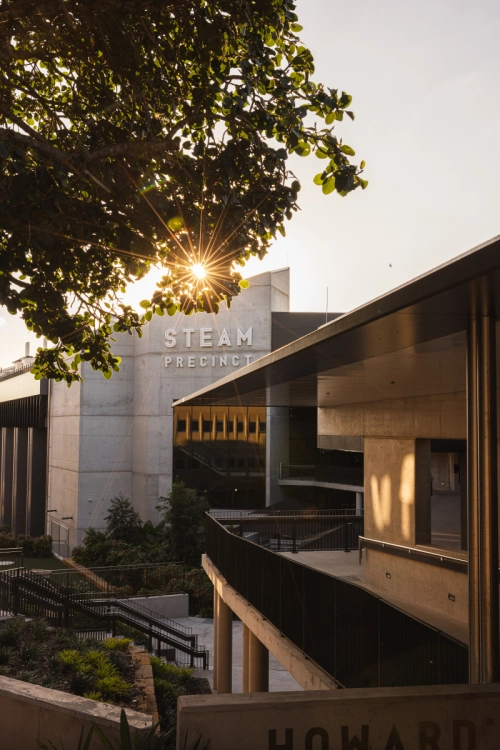Founded in 1868, Brisbane Grammar School is one of Australia’s leading schools for boys.
The School was founded under the provisions of the Grammar Schools Act 1860 and funded by the government and an enthusiastic group of public subscribers. The foundation stone was laid in 1868 by Prince Alfred, Duke of Edinburgh, at the original Roma Street site.
BGS officially opened one year later with 94 students and four masters, led by Headmaster Thomas Harlin. In 1881, the School moved to its current Spring Hill location, with the magnificent neo-gothic style Great Hall and classrooms opening that same year. The Boarding House followed in 1887, making BGS one of the first schools in Queensland to offer onsite boarding.
For more than 155 years, BGS has continued to evolve and expand:
- 1912: State-of-the-art science laboratories were built
- 1968: A new library and language lab opened
- 1976: Outdoor education began at Moogerah
- 1993: With the purchase of the former Primary Correspondence School in 1993 at the School’s southern boundary, the campus expanded to accommodate 1200 students
- 1997 - 2000: New sporting facilities opened, including the Northgate Playing Fields and the Indoor Sports Centre
In recent decades, BGS has embraced innovation while honouring its heritage:
- 2003: The Middle School opened with Years 6 and 7
- 2010: The Lilley Centre opened, blending digital technology with flexible learning spaces
- 2014: We welcomed our first Year 5 cohort
- 2024: The world-class STEAM Precinct opened, offering state-of-the-art facilities for Science, Technology, Engineering, Arts and Mathematics
- 2024: The Heritage Precinct opened
- 2025: A new Sports Science Gym was launched
Today, Brisbane Grammar School is home to around 2000 students and remains one of the leading academic schools in Queensland.
School Colours
Brisbane Grammar School has two sets of colours.
Red and Gold were introduced by Thomas Harlin, Headmaster 1869 -1876, and are now used as the academic colours. These were the colours of Peterhouse College at Cambridge, from which Harlin graduated.
Oxford and Cambridge Blue were the sporting colours introduced by Reginald Heber Roe, Headmaster 1876-1909, and are now used as our formal school colours. Roe graduated from Balliol College at Oxford and combined the “Light-Dark Blue” of the two great universities.
School Motto
"Nil Sine Labore" is the school motto, meaning Nothing Without Hard Work.
The word ‘hard’ is significant. ‘Labore’ has the connotation of something that requires grit, effort and determination to achieve reward. It is often more strenuous and rigorous than the idea of ‘opus’ or work alone.
Learn more about the people, places and institutions at the Brisbane Grammar School:
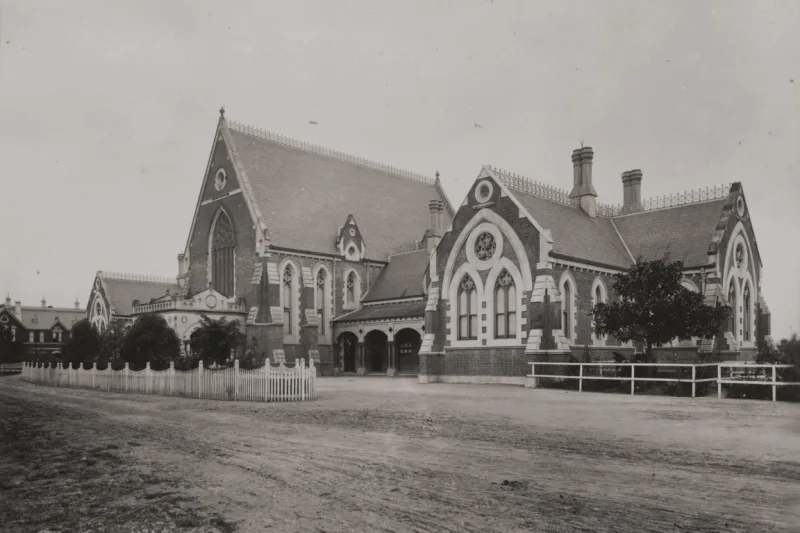
This Gothic Revival hall has been the centre of school life since first opening its doors to students in 1881.
The School, which originally opened at Roma Street in 1869, was relocated to its new hilltop position on Gregory Terrace following the expansion of the railway network.
The Chairman of Trustees the Hon Charles Lilley (later Sir Charles) laid the foundation stone on 28 November 1879 using a sterling silver trowel.
The Great Hall, with its decorative portico entrance carved from Oamaru stone, was designed by architect James Cowlishaw in 1879 and built in 1880.
The magnificent stained glass windows at the northern and southern ends of the hall showcase images of great men and honours which aimed to inspire students.
The hall was flanked by single-storey classroom wings. A second storey was added to the two wings in 1926 to accommodate more students.
It was the School’s main assembly hall from early 1881 until the Centenary Hall opened in 1969 to accommodate the growing number of students.
It is the venue for many student and Old Boy functions, from musical recitals and year group assemblies to weddings and memorial services. The Great Hall is the place students enter when they commence at the School and from where they depart at graduation.
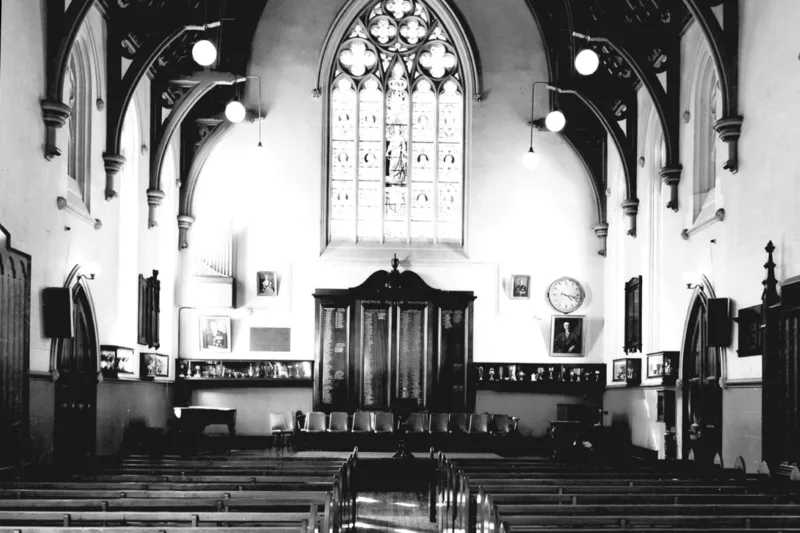
The Great Hall stands as a symbol to the importance of education.
The Great Hall’s impressive portico entry of Oamuru stone bears a number of carvings, including the foliage motifs of shamrock, holly and oak. A bust of King Alfred, the 9th century English king who promoted the value of education, sits on the outside of the central column.
The gargoyles on either side of the great cedar doors, one representing a serpent and the other a dragon, are a typical medieval feature to frighten away evil spirits.
The lofty interior is equally impressive with its exposed timber ceiling painted sky blue and dotted with gold stars.
The beautiful stained-glass windows at either end of the building, made by Ferguson and Urie of Melbourne, are thought to be the earliest Australian-produced windows in Queensland.
Both windows portray the School’s ideals. The northern window shows young Queen Victoria flanked by famous men in British history – maritime and military leaders, statesmen, poets, playwrights, and men of science – looking down on the boys inviting them to ‘emulate their noble deeds’. The southern window portrays the rewards bestowed by the Crown for loyalty and service.
Lining the walls are honour boards and plaques paying tribute to the war record of Old Boys as well as the distinguished service of trustees and staff. Though now too small for assemblies, the Great Hall continues to be an integral part of the ebb and flow of life at the School since first opening to students in 1881.
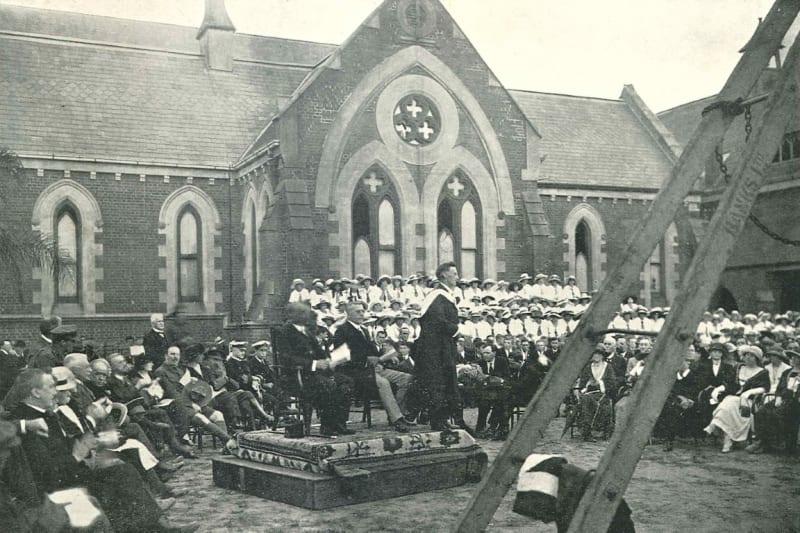
The War Memorial Library was built to honour the School’s Old Boys who served in the First World War, especially those who died in the conflict.
Justice John Laskey Woolcock, as Chairman of the School War Memorial Committee, was instrumental in ensuring that a library would be the most appropriate memorial to these Old Boys.
The building’s foundation stone was laid by the Governor of Queensland Sir Matthew Nathan on Anzac Day 1923. Material placed underneath included items that had been beneath the foundation stone of the original School at Roma Street.
The War Memorial Library was formally opened with a golden key by Sir Matthew Nathan on Armistice Day, 11 November 1924.
This octagonal-shaped building in the Gothic Revival style was designed by a past student, architect John Barr. The 12 stained-glass windows and much of the furniture were designed by Charles Tute, a stained-glass artist and cabinet maker.
The entrances to the building are under the windows Victoria (Victory) and Pax (Peace). Inside are plaques on either side of the main entrance listing the names of Old Boys who made the ultimate sacrifice.
The library was to house reference books as well as The Golden Book. This four-volume, hand-written record of the 1020 Old Boy veterans of the First World War was produced in 1924. Books and memorabilia were donated to the library, making it the shrine of memories that the School community wanted.
By the late 1960s the building could no longer accommodate the School’s growing collection of books. It was converted into a museum when the Centenary Library opened in 1969.
The War Memorial Library showcases artefacts and memorabilia about the School’s history and is opened for special events such as Open Day.
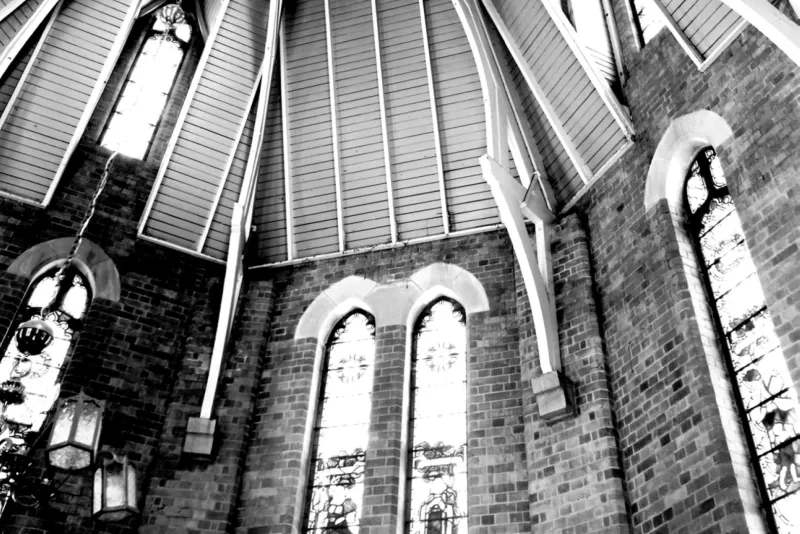
The magnificent stained-glass windows are dedicated to the memory of Old Boys who died in The Great War.
They were designed by Charles Tute, based on suggestions by War Memorial Library architect John Barr.
The 12 windows represent the chivalrous qualities considered to be worthy goals for the boys of the School. Clockwise from the northern end of the building they represent Pax (Peace) over the main entrance; Aequitas (Justice); Magnanimitas (Magnanimity); Humanitas (Courtesy); Honestas (Honour); Officium (Service); Victoria (Victory) over the southern entry; Fortitudo (Fortitude); Reverentia (Reverence); Fides (Loyalty); Pietas (Duty); and Veritas (Truth).
The former library, now a museum, has many items of historical significance. This includes the four volumes of ‘The Golden Book’, produced in 1924, a hand-written record of the 1020 Old Boys who volunteered for service during The Great War. The names of the 176 who made the ultimate sacrifice appear on plaques either side of the main entrance.
This book is of national significance and is kept in the BGS Archives when not on display.
Above the south entry is the mounted propeller from Old Boy Cedric Hill’s Tiger Moth with a photograph of him inserted into its centre. The plane crashed in 1930 when he tried to beat Bert Hinkler’s time for a solo flight to Australia.
In a daring exploit in 1918 Hill collaborated with a fellow prisoner-of-war to escape from the clutches of the Turks after two years in captivity by feigning insanity. During the Second World War he had operational commands in Britain and the Middle East.
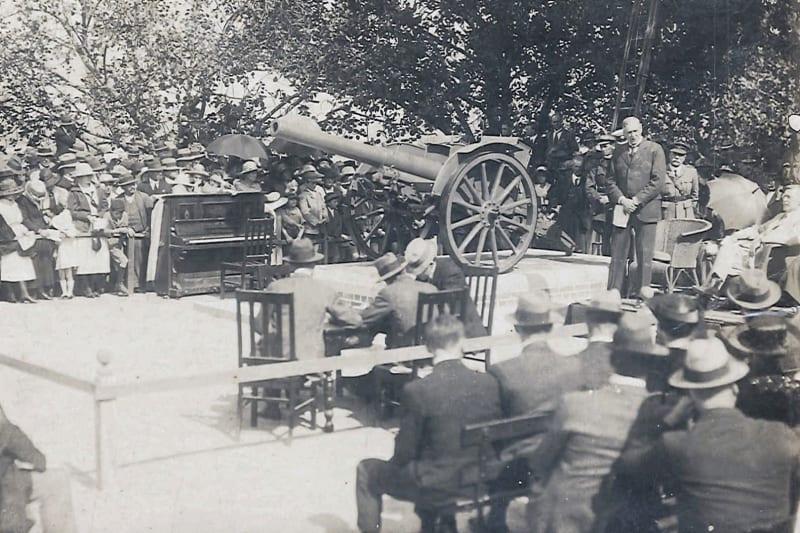
One of the School’s most affectionately regarded icons – the gun outside the Great Hall – was captured by a renowned Old Boy in the dying days of the Great War.
This Austrian-made Skoda 10.4 field artillery gun was manufactured in 1917 and pressed into service by the Turkish Army in Palestine where it was captured.
On 20 September 1918, Brigadier-General Lachlan Wilson, an Old Boy of the School, in command of the 3rd Light Horse Brigade, along with Lieutenant Hammond and Trooper Higgins, captured the field gun and 40 Turkish soldiers on the outskirts of Jenin.
The 3rd Light Horse Brigade was part of a cavalry offensive that succeeded in capturing the town at an important stage of the conquest of Palestine in the war with Turkey.
Originally the gun was to be sent as a war trophy to Bombay. However, Brigadier-General Wilson’s application, combined with the aid of another distinguished Old Boy, Lieutenant Colonel Donald Charles Cameron, and Alderman J.F. Maxwell, ensured the gun was allotted to the School.
The presentation was made by the Australian War Trophies Commission to commemorate the distinguished service of the School’s Old Boys in the Great War.
The gun was placed on a pedestal in the centre of the School’s main driveway.
The bronze plaque on the plinth is inscribed:
THIS GUN – WITH 8,107 TURKS AND GERMANS
– WAS CAPTURED AT JENIN, PALESTINE,
ON THE 20TH SEPTEMBER 1918, BY
BRIGADIER-GENERAL L.C. WILSON
C.B. C.M.G. D.S.O. CROIX DE G,
3RD LIGHT HORSE BRIGADE, A.I.F.
AN “OLD BOY” OF THIS SCHOOL
The gun was officially unveiled by the Governor of Australia, Lord Forster, on 11 August 1921. Student cadets formed a guard of honour, flags adorned the grounds and entry arch for the vice regal party, the HMAS Melbourne band provided the music, and the event concluded with the ‘The Last Post’ and the assembly singing the Doxology.
In 1993 the gun was removed from the grounds to be restored. Much of the work for this joint initiative of the School and Old Boys’ Association was carried out by tradesmen and apprentices of the Australian Army’s South Queensland Logistics Group.
The gun was returned to the School on Foundation Day, 23 February 1996 and placed closer to the Great Hall where it stands as a tangible reminder of the bravery and sacrifices made by Old Boy veterans of the First World War.
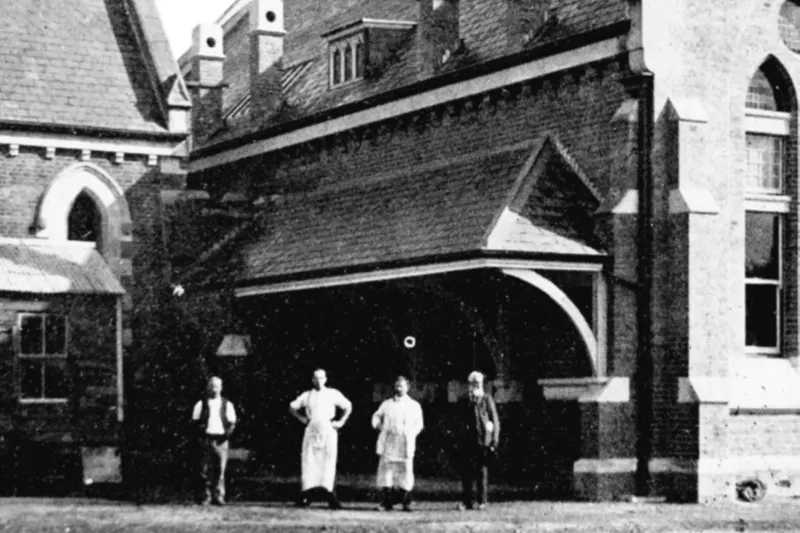
The Administration Centre, now over 100 years old, has been adapted to the changing needs of the School over time.
The building was originally constructed as a science wing. It was officially opened on 26 July 1912 by His Excellency Sir William MacGregor, the Governor of Queensland, when he placed the last brick in position with an inscribed silver trowel.
Sir William MacGregor said that the opening of the laboratories marked an important epoch in the history of education in Queensland and showed that the Trustees were noting advances in education elsewhere.
The new science wing was the first building to be constructed since the opening of the School on Gregory Terrace in 1881. Building costs were funded by selling endowment land and a Queensland Treasury grant.
The architect George Payne designed the science wing as a contemporary and complementary interpretation of James Cowlishaw’s Gothic-inspired main building.
The science wing comprised a large chemistry laboratory and smaller physics laboratory with timber galleries. These classrooms were impressive double-storey height spaces with exposed roof structures, clerestory lighting and ventilation.
In 1928 a bellcote, designed by Arnold Brooks, and bell were erected on the wall of the building facing the Newell Quadrangle. They were the gift of Old Boys in memory of George Rilatt – the School janitor and ‘ringer of bells’.
The building underwent major renovations as part of the School’s Centenary Building Project. It was converted into administrative offices and masters’ common rooms by School architect Colin Trapp and opened in 1966.
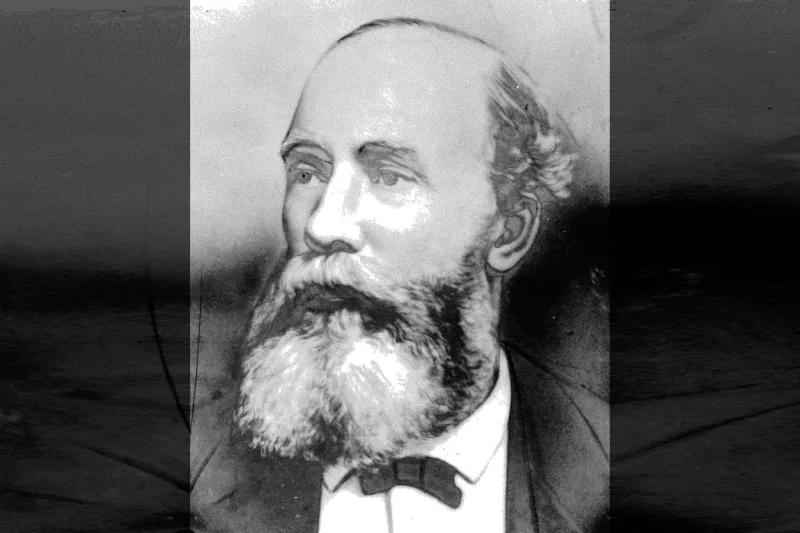
Sir Charles Lilley, journalist, politician and judge, was unwavering in his vision and efforts for a comprehensive system of free education in Queensland during the 41 years he lived in the colony.
As early as 1859 Lilley campaigned to establish a School of Arts to promote adult education and became the first president of the Queensland Liberal Association.
His brilliant oratory skills made him a persuasive force in parliament and on the bench. He was MLA for Fortitude Valley from 1860 to 1874, and earned the nickname ‘Lilley of the Valley’. The Federal Seat of Lilley was named after him. He held many cabinet positions during his political career, including that of Attorney-General. Lilley was Premier from 1868 to 1870. When he resigned from politics in 1874 he became Judge of the Supreme Court of Queensland, then Queensland’s second Chief Justice from 1879 to 1893. Lilley was knighted in 1881.
Championing liberal and sometimes radical views, Lilley used his political influence to embrace many causes, particularly education. As Premier he abolished school fees, making Queensland the first colony to introduce free primary education in 1870. He was hailed by many as the real father of Queensland’s system of free, compulsory and secular education.
From 1874 to 1875 Lilley chaired a royal commission on the working of the colony’s educational institutions. His report provided the basis of the State Education Act 1875 which launched a modern system of education in Queensland.
In 1891 he chaired a royal commission to establish a university in Queensland, reflecting his long-held support for tertiary education. However, he did not live to see the university founded in 1909.
In paying tribute to Sir Charles Lilley, who died on 20 August 1897, Headmaster Reginald Heber Roe said that Lilley ‘believed with all his heart in the necessity for higher education, both as a means of raising the standard of thoughtfulness and refinement in our homes, and as an instrument for the scientific development of the material resources of our country’.
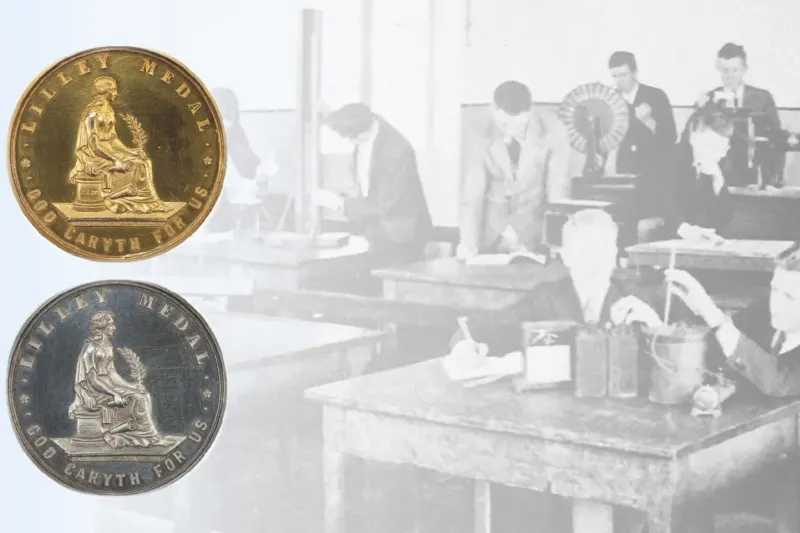
The Lilley Medals are the School’s most prestigious academic awards. They were founded in 1869 by Sir Charles Lilley, then a Trustee and Premier of Queensland.
- The Lilley Gold Medal is awarded to the Dux of the school
- The Lilley Silver Medal (Upper School) is awarded to the Dux of Year 10
- The Lilley Silver Medal (Lower School) is awarded to an outstanding scholar in Year 9
The obverse of the medal depicts the Greek Muse Clio, the Goddess of Historical Writers. She is ready to present the sprig of laurel and holds a scroll, symbols of knowledge and wisdom. The reverse contains the recipient’s name circled by a laurel wreath, a symbol of victory and honour at the ancient Greek games.
A large collection of medals is on display in the museum and donations are always gratefully accepted.
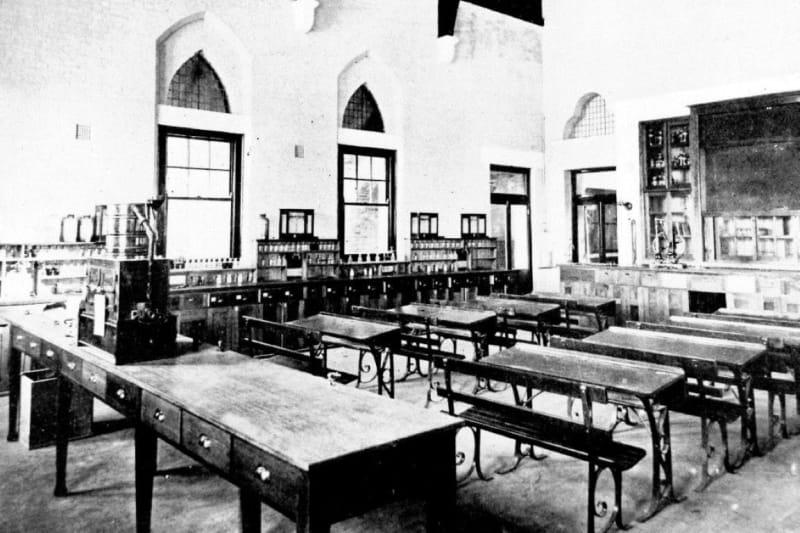
This former staff common room was renamed the Woolcock Room in 1993 to acknowledge Justice John Laskey Woolcock’s 40 years of service to the School.
The lofty space was originally part of the School’s science wing, opened in 1912. Woolcock – a strong advocate of science teaching – was a driving force in securing government funds towards building costs.
Woolcock was one of the longest-serving and most influential members of the Board of Trustees, joining in 1889 and serving as Chairman from 1906 until his untimely death on 18 January 1929.
His efforts to shape the School’s English and Science teaching policies reflected his own academic interests and achievements. A student at the School from 1875-1880, he won a scholarship to the University of Sydney where he excelled in humanities and sciences.
Woolcock returned to teach at the School in 1883, reviving a school magazine, before pursuing a brilliant legal career. He was private secretary to Sir Samuel Griffith, during Griffith’s first term as Premier from 1883-1888. Woolcock was admitted as a barrister of the Supreme Court of Queensland in 1887, appointed Parliamentary Council in 1899 and became a judge of the Supreme Court in 1927.
As Chairman of the School War Memorial Committee, Woolcock ensured that a library would be the most appropriate memorial to the School’s veterans of The Great War.
In 1922 he presented the Woolcock Challenge Cup in memory of Old Boys who fell in this conflict. This cup is awarded annually for an English essay or poem on some subject associated with Australia’s role in war or the pursuit of peace.
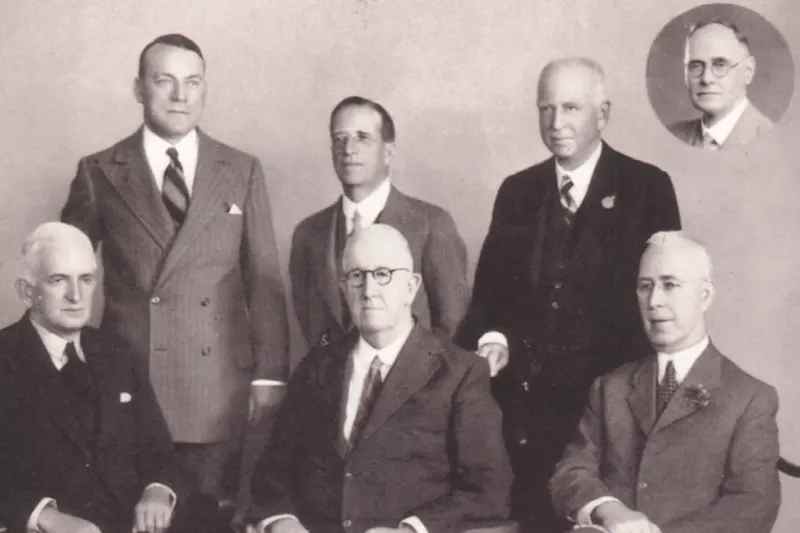
Brisbane Grammar School is governed by a Board of Trustees – the School’s supreme administering body with wide-ranging responsibilities governing its management and growth.
The role of the Trustees was defined in the Grammar Schools Act 1860. The Act stated that learning was to be encouraged by establishing public grammar schools to provide ‘all classes and denominations’ of residents in the Colony of Queensland with ‘the advantages of a regular and liberal course of education’.
This Queensland legislation was unique in Australia at that time and provided a form of public-private partnership to provide education for the new colony. Under the original provisions, any municipality in Queensland in which £1,000 had been privately subscribed for establishing a grammar school became entitled to claim from the Government a grant of £2,000 and an annual endowment of £500 per annum.
The Board of Trustees was to comprise four members appointed by the Governor in Council and three elected by subscribers or donors to the School, thus maintaining the partnership between community and government.
On the 25th January 1868 the subscribers met at the Town Hall and elected Lewis Bernays, William Brookes (Treasurer) and Randal MacDonnell. Appointed by the government were the chairman, the Hon Thomas Blacket Stephens, and the Hon Charles Lilley, later chairman and Chief Justice of Queensland. Lilley was a towering figure in securing education for all Queenslanders and endowed our Lilley medals. Also appointed were Dr Kevin O’Doherty, responsible for Queensland’s first health act and Alexander Pritchard.
The Trustees of Brisbane Grammar School have, since the foundation of the school, given their time on a voluntary basis. They have been represented by many fields of community endeavour from the legislature, judiciary and the law, to medicine, science, the services and business.
Many significant figures have devoted their time as a trustee. One of the most important was Sir Samuel Griffith, a major contributor to the 1875 Education Act in Queensland. He served the board for 33 years, twice as chairman. He was a principal author of the Australian Constitution and became the first Chief Justice of the High Court.
Other notable trustees include Justice John Woolcock served the board for 40 years and was Chairman 1906 -1929 and Mr Howard Stack who served a record 28 years as chair retiring in 2019. In 1995, for the first time, two women were appointed to serve on the Board, Dr Cherrell Hirst AO and Mrs Judith Bell AM, who served 16 years.
The trustees are responsible for the financial security and strategic direction of the school. Their expertise and guidance have been crucial to the school’s development. The BGS Annals recorded in 1923 that:
“the continuous success of the institution has in large measure resulted from the progressive policy of the trustees and their confidence in and sympathy with the headmaster and his staff.”
The election and appointment of the trustees was originally on a triennial basis. Now the trustees hold office for four years and at the end of that time are eligible for re-election or re-appointment.
Brisbane Grammar School was one of eight Queensland grammar schools established under the 1860 Act during the 1800s. In 2000 these schools established the Queensland Grammar Schools Association. The Board of Trustees has steered the School through changing economic and political times to ensure the values enshrined in the Grammar Schools Act are maintained.
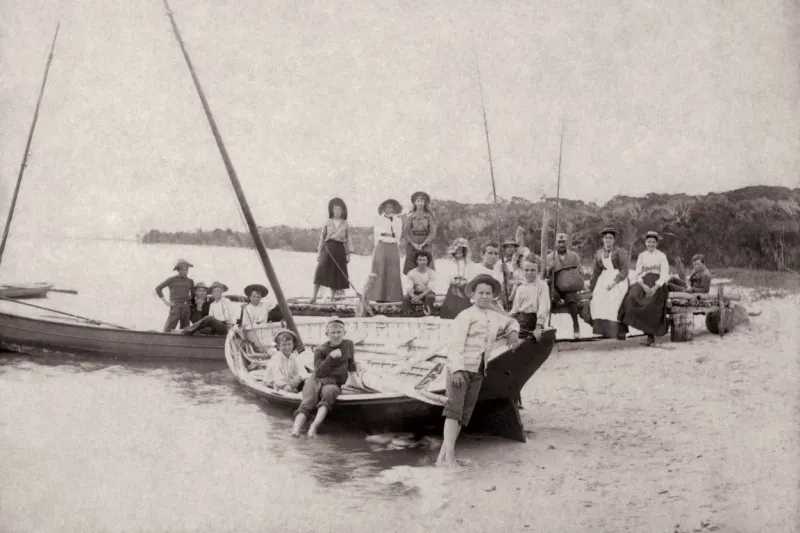
Brisbane Grammar School’s first camp, established by the early 1880s on South Stradbroke Island by Headmaster Reginald Heber Roe, proved to be a trailblazer for outdoor education training in Australia.
Although several early Australian schools provided ‘Saturday rambles’, Roe’s Kamp was reputed to be the first to establish the principle of outdoor living and camping as an educational principle in Australia.
The idea for a school camp came after Roe went on a camping trip to the island with W.E. Box and Captain Whish and his family in 1878.
The three friends subsequently purchased adjacent blocks of land in 1882 at the southern end of the island and a camp was established on Roe’s 11-acre block which they called Whirobo, an acronym of their names.
In 1885, the first hut was built of galvanised iron and served as a store for tents, tools and utensils, and as a sheltered kitchen and emergency living quarters during bad weather.
At some stage after 1890 Whirobo Camp was renamed Roe’s Kamp, the spelling meant to convey mischievous humour and perhaps signal its humble establishment in a setting not grand enough to be formally designated as a 'Camp'.
The Skipper, as Reginald Heber was universally known, and his wife Maud, Captain Whish’s daughter, took boarders from Grammar’s School House for regular holidays and excursions to Roe’s Kamp.
On many occasions there would be several dozen boys together with members of the extended Roe and Whish families.
The camp reflected Roe’s philosophical commitment to ensuring that an academic education be integrated into all-round development. Here the boys were able to enjoy communal living and comradeship far removed from the classroom environment.
Days were spent, exploring, hunting, fishing, swimming, sailing and canoeing and at night the boys would read and play games until bedtimes, sometimes preceded by furious battles in the dark using sugar bags stuffed with soft material.
Roe’s Camp was almost swallowed up by the sea in 1938, despite the installation of trenches and walls. It was subsequently dismantled and relocated further north at Picnic Point.
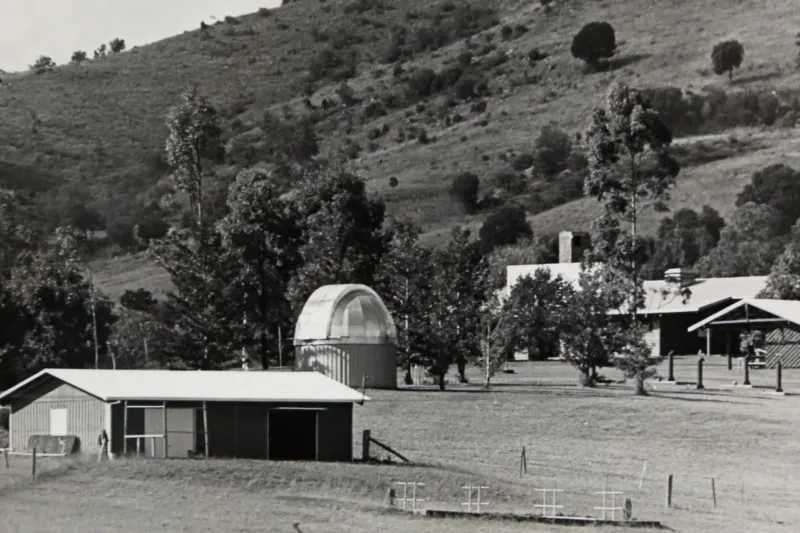
A new camp was established near Lake Moogerah by headmaster Max Howell in 1976 which reflected the philosophy espoused nearly a century earlier by Reginald Heber Roe, that outdoor living should be integral to a student’s education.
This purpose-built centre at Pepperina Hill was officially opened by the Governor of Queensland, Air Marshall Sir Colin Hannah on 30 May 1976.
The camp project was driven by a dedicated team in the Parents and Friends’ Association which oversaw the acquisition of a suitable site on a long lease from the Irrigation and Water Supply Commission.
Initially the outdoor education centre consisted of the main kitchen, dining room, dormitory building, boatshed and accommodation for staff which made it possible to run regular class excursions.
An astronomical observatory was built in 1982 with improvements four years later to make it easier to track stellar objects. Expansion of activities also included a ropes course and climbing tower.
Today, the School sends each form class from Years 8, 9 and 10 to the Moogerah Outdoor Education Centre to strengthen intra-class relationships and morale, as well as develop team-building and leadership skills.
Year 6 and 7 students visit the camp for a shorter period each year. Form Seniors also attend the camp in their mentoring role with younger students.
The five-day program includes rock-climbing, bushwalking, orienteering, canoeing as well as a camp-out in the bush at the foot of one of the nearby mountains.
Moogerah is also used for writers’ camps, composers’ camps, scientist-in-residence camps, and InterSchool Christian Fellowship camps. It is also used for other activities such as sports training, astronomy, sky viewings and fieldwork in senior courses.
Constant updating of facilities and courses, coupled with the dedication and enthusiasm of the Grammar community will ensure the experiential-based program remains relevant for a broad and fulfilling education at the School.
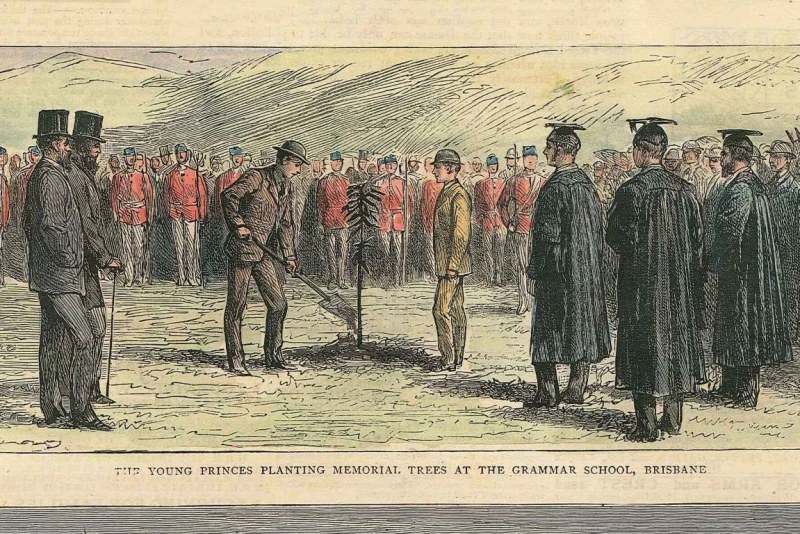
Four occasions spanning over 100 years in the School’s history have been marked by royal visits.
Five occasions spanning over 100 years in the School’s history have been marked by royal visits.
The first royal visit took place on Saturday 29 February 1868 when the third son of Queen Victoria, HRH Prince Alfred – later Duke of Edinburgh – laid the foundation stone of the original School at Roma Street in front of a guard of honour and hundreds of spectators. The event was commemorated in the present School with his coat-of-arms included in the northern stained-glass window of the Great Hall.
Twelve years later, on Friday 19 August 1881, the two eldest sons of the future King Edward VII (the eldest son of Queen Victoria) visited the new School on Gregory Terrace. Prince Albert, (often referred to as Edward) and his younger brother, Prince George (later King George V) each planted a Moreton Bay Fig tree in the School grounds to commemorate their visit to the school.
In their address to the audience from both Grammar Schools, they referred to their uncle’s earlier visit in 1868 and his association with the foundation of the School. The princes then handed the Headmaster, Reginald Heber Roe, their letter of appreciation to the boys of the School stating, that while in Sydney, they had ‘heard of those of your schoolmates who had achieved distinction in the university examination there’. The original copy is on display in our museum.
On 27 May 1968 Prince Philip, the Duke of Edinburgh, visited the School during its centenary celebrations and planted a Queensland Hoop Pine tree on the lawn between the trees planted by the two princes some 80 years earlier. He then addressed an assembly of nearly 4,000 people on the School oval.
Prince Philip returned to the School on Thursday 10 March 1977 to present the Duke of Edinburgh Awards in the School’s Centenary Hall. He expressed his pleasure to have been able to visit the School again and was particularly gratified to note the number of young people participating in the Duke of Edinburgh Scheme.
As part of the sesquicentenary celebrations in 2018, Prince Edward, the third son of Queen Elizabeth II and the third Duke of Edinburgh to visit the school planted a tree on the boarders’ lawn.
The four trees planted by members of the royal family now form part of a boarder of trees flanking the boarders’ lawn in front of the Roe Building. They are part of the School’s historic fabric and have become familiar landmarks to generations of students.
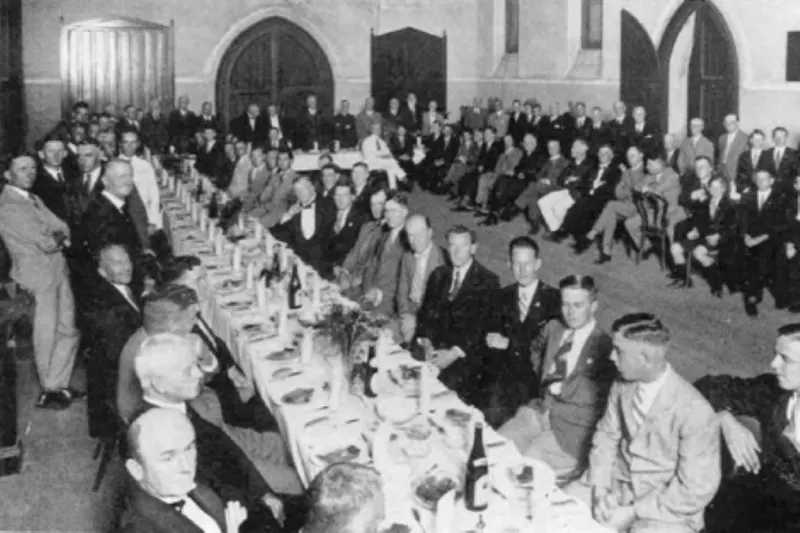
In 1884 a small society of Old Boys called the ‘Reunion’ was formed which operated for two years. However, it was not until 1 June 1898 that the present body, the Brisbane Grammar School Old Boys’ Association (BGSOBA) was formed with the headmaster, Reginald Heber Roe, appointed its first president.
Three sub-committees were appointed: Amusements (to prepare the program of meetings and arrange for annual reunions); Sports (to organise clubs for outdoor sports); Education (to promote ‘intellectual pursuits’ among members).
The first ordinary meeting was held at the fashionable Café Eschenhagen in Queen Street on Wednesday 27 July 1898. The draft of the BGSOBA Constitution and Rules was finally settled with between 40 and 50 of the 200 members in attendance.
At its inception the BGSOBA decided to establish a fund for presenting prizes for school work and sports.
Despite an enthusiastic membership the association had financial troubles when a fire destroyed its premises and property in 1909.
The BGSOBA was reinvigorated when John Gabriel Nowlan took over as secretary and treasurer in 1910 – the year he joined the School as an Assistant Master. His belief that every boy leaving the School should join the BGSOBA saw membership increase to 1000 by 1922.
Over the years, the BGSOBA has helped to finance many school projects and funds bursaries which are presented on Foundation Day.
In July 1920 the School Jubilee celebrations were represented by a committee representing the BGSOBA and the War Memorial Committee.
Raising funds for the War Memorial Library was carried out largely by the BGSOBA, with past student Charles Bennet Fox writing ‘The Golden Book’ entries of Old Boy veterans of the Great War.
In 1938 the association formed an appointments board to help past and present pupils find suitable jobs to counter the effects the Great Depression had on them finding employment.
In the postwar years the BGSOBA contributed funding to memorial projects such as the World War II Honour Board in the Great Hall, unveiled in 1949, and the gymnasium and swimming pool which opened in 1953 and 1954 respectively.
More recently the association has assisted with appeals associated with the Centenary Building Fund in 1964 and the Lilley Centre which opened in 2010. The bridge linking the main campus with the Indoor Sports Centre was officially named The Old Boys’ Bridge in recognition of the BGSOBA’s financial contribution to the School’s structures.
From its humble beginnings the BGSOBA’s membership has grown to some 2000 life members. As a custodian of the School’s traditions, which includes the annual Old Boys’ Reunion Dinner, the BGSOBA encourages fellowship between different generations of Old Boys and how they can serve the School community
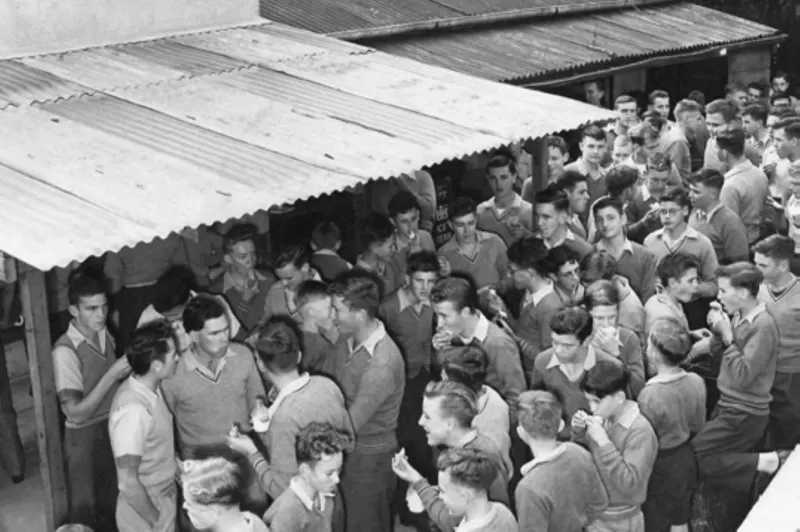
The Parents and Friends’ Association is the ultimate cooperative through which parents and friends channel their voluntary services for the benefit of the whole School community.
The Parents and Friends’ (P & F) Association has been the umbrella organisation for coordinating the School’s support groups since 1972.
The Association provides the administrative framework for these groups which undertake numerous extra-curricular activities to raise funds for the School where needed.
Each group has its own management body, with group presidents reporting to the P & F Association Management Committee every term.
The oldest of these support groups is the P&F Auxiliary. It evolved shortly after the Second World War when a small group of mothers formed a ladies’ committee to supply School lunches and make donations to the Headmaster’s Amenities Fund.
Since that time, and with the continued support of the School and parents, the Auxiliary has grown into the large organisation that it is today. One of its core activities is administering and staffing the Grammar Shop (uniforms, books and stationery) and the Tuckshop.
Over the years the Auxiliary has provided funding assistance to refurbish and construct School buildings and amenities. It has contributed major donations to the Centenary building fund with more than $3.5 million towards the Lilley Centre, Arts Centre, Indoor Sports Centre and Centenary Courtyard redevelopment.
A memorable gesture by the Auxiliary has been its funding of the Great Hall’s beautiful Millennium Window depicting a boy’s journey through Grammar school life.
The Auxiliary contributes in many ways to the social and cultural life of the School by providing support for key School events and organising functions for the parent community. It offers a way for parents to meet, make lifelong friends and be involved in their sons’ careers at the School, with the opportunity for continued interaction through the Parents of Past Student groups.
The volunteer support of parents is as invaluable today as it was in the early days. Their active participation in the life of the School is one of the most significant factors in promoting the wellbeing of the students.
In 2011 the Auxiliary Committee developed its motto, Connect-Care-Contribute. These words embody the vital functions that this support group has given to the School community since its inception.
The commitment of the Auxiliary through its services and funding contributions continues to enhance the welfare of every student on his journey through Brisbane Grammar School.
Since our foundation the Queensland Governor has held the role of Official Visitor to the school. This vice-regal patronage is not automatically transferred but has been bestowed personally by each Governor.
In 1923 the BGS Annals said of our Visitors that “…successive visitors have, without exception, evinced a deep interest in the welfare of the school and the boys.”
Governor Sir George Bowen in 1868 endowed one of our most prestigious academic prizes, awarded to this day for proxime accessit (runner-up) to the dux of the school. Governor Sir William Macgregor laid the foundation stone of the War Memorial Library in 1923, and Governor Leneen Forde opened the refurbished Roe Building in 1993.
Brisbane Grammar School acknowledges Her Excellency the Honourable Dr Jeannette Young AC PSM, Governor of Queensland as the School's Official Visitor.
Her Excellency has been our Visitor since being sworn-in as the 27th Governor of Queensland on 1 November 2021.
The Governor was born in Sydney and graduated in Medicine from the University of Sydney.
In August 2005, the Governor was appointed to the role of Chief Health Officer for Queensland. In January 2020, when the COVID-19 virus outbreak was declared a pandemic, the Governor became the State Health Incident Controller.
Amongst her numerous qualifications and honours, Dr Young was appointed a Companion of the order of Australia in 2022.
BGS Archives and Achievements
Created as part of Brisbane Grammar School’s sesquicentenary history project, the Awards Chronicle is a searchable database featuring over 6,000 entries across 114 prize lists. This includes academic prizes, scholarships, captains and champions of sport.
While some prizes were open to Year 11 and Year 12 students (Form V and VI), only Year 12 recipients are currently listed. We look forward to expanding the lists in future updates.
Each list is anchored by the current prize title. Where relevant, changes to endowments or conditions are explained.
Every entry has been carefully compiled, although occasional inaccuracies may still exist. If you have a query, please email Community Relations
Explore the Awards Chronicle below, using the instructions and filter options provided.
Please note that the chronicle is optimised for desktop viewing and will not display properly on mobile devices
The Golden Book contains the names and records of the known 1,020 Old Boys who volunteered for service in World War I. Spanning four volumes, each name and record is handwritten on its own page, framed by an interlacing border of Flanders poppies.
Bound in brown calf leather with gilt-edged pages sewn in with pale blue silk, the Golden Book was the central feature of the War Memorial Library when it opened in 1924.
It was compiled by Stuart Stephenson, Deputy Headmaster at the time and later Headmaster from 1928 to 1940. The calligraphy was the work of Old Boy Charles Bennett Fox, a pupil from 1875-1879 and later a Trustee from 1922-1939. The poppy border was designed by Madge Roe, daughter of former Headmaster Reginald Heber Roe.
The Golden Book has been scanned in high resolution and is available to view online. The original volumes are housed in the Stephenson Reading Room within the Heritage Precinct.
In 1904, Arthur Stanley Roe became Queensland’s first Rhodes Scholar, attending Balliol College, University of Oxford. Since then, 26 BGS Old Boys have received Queensland or Australia-at-Large Rhodes Scholarships. A list of scholarship recipients is detailed below.
| Year of Election | Name |
|---|---|
| 1904 | Arthur S Roe |
| 1905 | Norman Leslie |
| 1908 | Stanley Castlehow |
| 1909 | Leonard G Brown |
| 1911 | Harold K Denham |
| 1914 | Allan W L Row |
| 1915 | John N Radcliffe |
| 1918 | Frederick W Paterson |
| 1919 | Victor Grenning |
| 1922 | Tom Lawton |
| 1927 | Franz Konrad Saddler Hirschfeld |
| 1928 | John H Lavery |
| 1930 | Cecil E Kerr |
| 1939 | James K Newman |
| 1958 | Thomas Baxter |
| 1960 | Clive P Hildebrand |
| 1967 | John M Fenwick |
| 1978 | Peter J Wetherall |
| 1981 | Donald Markwell |
| 1982 | David M Rose |
| 1991 | Craig Arnott |
| 1992 | Daniel V Botsman |
| 2006 | Nicholas I Luke |
| 2007 | Ryan A Goss |
| 2019 | Nicholas Salmon |
| 2024 | Jeremy Hunt |
The Brisbane Grammar School Magazine provides a valuable written and pictorial record of school life. The first 22 years of the BGS Magazine, from 1898 to 1920, have been digitised and can be viewed below.
This period was momentous in the School’s history, reflected in writings and photos about the Boer War and World War I, as well as School events, news, and student achievements.
The Rolls of Honour feature the names, school details, and service records of the 428 BGS Old Boys and two masters who have given their lives in war. Follow the link below to view the War Service database containing the following records:
- WWI Roll of Honour – 176 students and two masters
- WWII Roll of Honour – 250 students
- Boer War and Vietnam Rolls of Honour – 1 student each
Please note, the information listed comes from the School's records. Where there is a discrepancy with the Australian War Memorial or Department of Veterans' Affairs records, we have corrected dates in the WWI data and recorded the discrepancy in the WWII data. This will be updated in future editions of the database.
For more information on the School's history or for any queries relating to the Archives, please contact Community Relations by email, with the subject line Archives Request.
BGS Community Relations
Email: [email protected]


